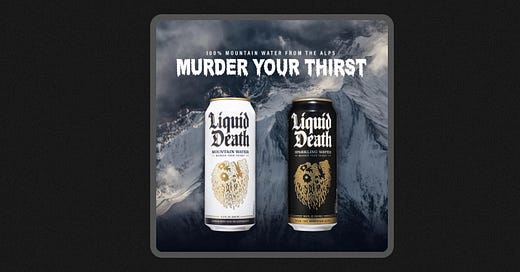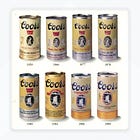
Liquid Death: Selling Rebellion, One Sip at a Time
A look at how Liquid Death is 'Murdering Your Thirst' and industry norms
Hello! I’m Pat and Better by Design is my newsletter sharing pragmatic insights for creative innovation through the lens of design. If you’re new here, join our growing tribe of design innovators!
Introduction
In a world where bottled water brands are synonymous with pristine mountain ranges and crystal-clear springs, Liquid Death made a splash as the rebellious outlier. With its audacious punk-rock ethos, the water brand has not only quenched thirst but ignited conversations and built a loyal following that has driven the company to a 700 million dollar valuation.
What roles do design and branding play in Liquid Death's disruptive strategy? Let's dive in and break down its anti-establishment approach to elevating a basic commodity into a hotly desired product.
Historical Contrast
Before Liquid Death, the bottled water industry focused its messaging primarily on health and wellness, often evoking images of tranquility and nature. Liquid Death shattered this mold, entering the scene with skull imagery and slogans like "Murder Your Thirst" and “Death to Plastic”, directly contrasting the peaceful image usually associated with bottled water brands.
Founder Mike Cessario’s key insight came while attending the Vans Warped Tour, where he found that bands were obscuring the water they were drinking behind the labels of the event sponsors, energy drinks like Monster. Both the performers and audience members needed to stay hydrated at these events, but existing water brands just didn’t fit the vibe.
Cessario sums up this core insight as:
Liquid Death for me is how do you get all these people who don’t typically make healthy decisions and now all of a sudden want to participate in a healthy brand purely from the brand standpoint at first. (Mike Cessario)
Now let’s explore how the brand delivered on that idea.
Design Insights
Become the one exciting product in a stale category
I love Virgin’s business strategy, which was find a really stale category of products and be the one really cool and exciting product in it. (Mike Cessario)
Liquid Death turned heads by flipping the script on the bottled water industry's typical narrative. Instead of tranquility and purity, they embodied audacity and punk-rock. This gamble not only set them apart but also created a loyal following among those tired of the status quo. In design and branding, defying the norms can help unearth untapped markets.
Specificity breeds loyalty
If someone sees this on the shelf, am I willing to bet they have to pick it up because it’s so weird or interesting and then they’re probably going to take their phone out, take a photo of it and post it on their social channels for free to their hundreds of followers. (Mike Cessario)
Rather than trying to please everyone, Liquid Death honed in on an audience that lives and breathes counter-culture. They built strong bonds through social media, guerrilla marketing, and even a pledge to "sell your soul" on their website. When it comes to branding, specificity breeds loyalty.
Weave a narrative that extends beyond the product
At the end of the day, we’re really creating an entertainment company and a water company. Like we don’t want to create marketing, we want to actually entertain people, make them laugh in service of a brand. And if you can do that, they’re going to love your brand because you’re giving them something of value. (Mike Cessario)
Liquid Death isn't just selling water; they're selling an ethos. Every element, from the bold can design to the provocative slogan "Murder Your Thirst", adds layers to the narrative. A well-crafted narrative stitches together the emotional fabric that can make your brand unforgettable, turning customers into evangelists.
Personal Reflection
I hardly have a single punk bone in my body, so I’m not exactly Liquid Death’s core demographic. The brand’s aesthetic is far from my own personal taste, the brashness of the messaging makes me borderline uncomfortable, and I know it’s just water at the end of the day... but still, I can’t look away.
That, to me, is the epitome of well-executed creative work and I admire the hell out of Liquid Death’s commitment to carving its own path.
Key Takeaways
Liquid Death's branding is a shining example of how a well-executed, counter-cultural strategy can create a buzz and a loyal following. From embracing an untapped niche to building a devoted community and an immersive narrative, Liquid Death serves as a potent reminder that the power of branding can turn even the most basic commodities into sought-after products and businesses.
Learn more
Links
Check out these sources for different perspectives
How Liquid Death's Founder Started A $700 Million Water Brand (video)
Why is Liquid Death SO popular? (video)
Even With A $700 Million Valuation, Liquid Death May Need A Lot Of Luck To Become Liquid Gold (article)
AI prompts
Run these in ChatGPT to explore aspects of the design in more detail
Product Differentiation: “What are some strategies for differentiating a product in a saturated market?”
Consumer Psychology: “Discuss the psychological principles that influence consumer behavior and how they are exploited in advertising.”
Brand archetype: “Which of the 12 brand archetypes based on Carl Jung’s theory does Liquid Death most closely align to?”
If you got a little value in this post, consider subscribing, sharing, or following me on Twitter. If you got a lot of value I’d appreciate it if you bought me a coffee 😎☕️.









